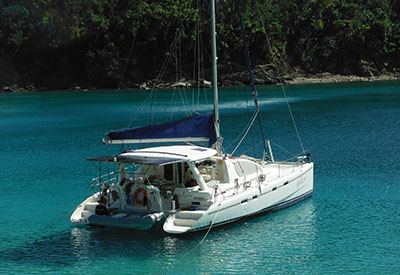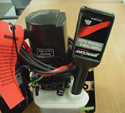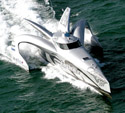Rigged to Run Hard: Engine Room Ideas and More
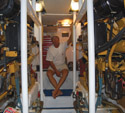
 We recently spent time aboard a 54′ Bertram called the Maple Leaf and the boat’s owner made a great comment about his boat. He said that he has not fixed up a used boat; his boat is in the process of 22 years of constant improvement!
We recently spent time aboard a 54′ Bertram called the Maple Leaf and the boat’s owner made a great comment about his boat. He said that he has not fixed up a used boat; his boat is in the process of 22 years of constant improvement!
I loved that attitude. Bertram’s 54 was designed and built as a sport fishing yacht and the only real advantage of moving to a new boat would be that it was new. The Bertram 54 is a recognized classic tournament boat and Bertrams the world over have earned an enviable reputation in competition.
The Maple Leaf has made an annual visit to the Bertram yard in Florida where it was maintained at peak condition and improved wherever the owner and his crew could improve it, especially in terms of being reliable, safe and most of all, durable. This boat is fished 12 months a year and the owner is rarely away for more than a few weeks at a time. Fishing trips and long-range cruising can bring you face-to-face with ugly weather and the boat has to be ready at all times.
Here our owner shares a few of the best engine room and rigging tricks he has learned after thousands of hours of running. We hope you find some useful for your boat!
To give you a size comparison, Captain Ricardo Eldon is at the forward bulkhead in the Maple Leaf’s engine room. Notice the full set of engine instruments on each of the Caterpillar Marine diesel engines. Each is monitored by a zoom lens video camera. Captain Rick can view each camera feed check on the Furuno NavNet3d screens at either helm. These provide a backup to the helm instruments. Also notice the substantial shop type tool kit behind him and the three ceiling lights. More lights are always better!
 Here is one of the three video cameras in the engine room. We love the idea of video monitoring your engine room. Especially during a long hard run, it’s very reassuring to look down there and make sure there’s no oil spray or smoke. Also, it enables you to see that no piece of equipment has come loose that could interfere with the engines.
Here is one of the three video cameras in the engine room. We love the idea of video monitoring your engine room. Especially during a long hard run, it’s very reassuring to look down there and make sure there’s no oil spray or smoke. Also, it enables you to see that no piece of equipment has come loose that could interfere with the engines.
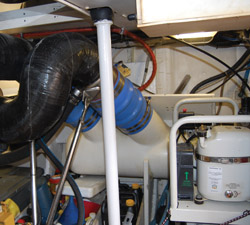 This is a full engine room but among the many things in this picture is another light (in the aft starboard corner). A Firebouy fire suppressant system by the door and a shelf over the Charles inverter carries a special pneumatic door system. A button-press opens the sliding cabin door or closes it using air pressure. In rough weather, you can hang on to something secure and stand back while the door opens or closes, eliminating the chance of accidentally slamming your own hand in the heavy door.
This is a full engine room but among the many things in this picture is another light (in the aft starboard corner). A Firebouy fire suppressant system by the door and a shelf over the Charles inverter carries a special pneumatic door system. A button-press opens the sliding cabin door or closes it using air pressure. In rough weather, you can hang on to something secure and stand back while the door opens or closes, eliminating the chance of accidentally slamming your own hand in the heavy door.
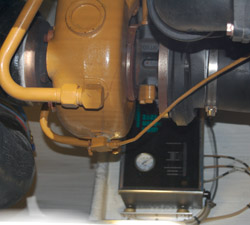 You can barely see it mounted behind the engine’s turbo but an Arid Bilge system has been installed. This system uses a series of small tubes running to places like the stuffing boxes where they slowly draw any drips or moisture away. The owner was skeptical when he first installed it, but now feels it does keep the bilge dry and eliminates oduors, making a great contribution to maintaining the boat.
You can barely see it mounted behind the engine’s turbo but an Arid Bilge system has been installed. This system uses a series of small tubes running to places like the stuffing boxes where they slowly draw any drips or moisture away. The owner was skeptical when he first installed it, but now feels it does keep the bilge dry and eliminates oduors, making a great contribution to maintaining the boat.
 This picture shows several important ideas. First, the camera in the foreground can be turned and zoomed to scan this whole area. On the left if you look closely, you’ll realize that the engine room ceiling is mirrored. Carefully placed polished steel is fireproof, unbreakable and enables you to see the top and far side of the engines that you cannot reach without removing the salon floor. Also notice another excellent improvement; there is a padded edge covering over the entrance to the engine room hatch, preventing people from hitting their heads in rough weather. Every boat needs that.
This picture shows several important ideas. First, the camera in the foreground can be turned and zoomed to scan this whole area. On the left if you look closely, you’ll realize that the engine room ceiling is mirrored. Carefully placed polished steel is fireproof, unbreakable and enables you to see the top and far side of the engines that you cannot reach without removing the salon floor. Also notice another excellent improvement; there is a padded edge covering over the entrance to the engine room hatch, preventing people from hitting their heads in rough weather. Every boat needs that.
 As long as you are detailing your engine room this winter, how about some other ideas? This is a great example of solving a problem that you learn about after going cruising. A wine rack in the central companionway has been fitted with a snap-on clear plastic cover. You can see what’s in the rack, but the cover keeps the bottles in their slots instead of on the floor after rough ride.
As long as you are detailing your engine room this winter, how about some other ideas? This is a great example of solving a problem that you learn about after going cruising. A wine rack in the central companionway has been fitted with a snap-on clear plastic cover. You can see what’s in the rack, but the cover keeps the bottles in their slots instead of on the floor after rough ride.
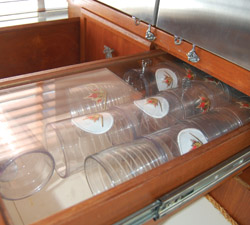 Many boats have space up high. In this case, when the owner refitted the Maple Leaf with a double-door, stainless steel refrigerator, there was room for a pair of drawers above. The obvious problem would be knowing what was in the drawer above your head! The solution was to give the drawer a clear Plexiglas bottom. Now you can see the contents easily, to reach over and get something out of the drawer. Also notice the hooks the owner added to secure the refrigerator doors during hard running.
Many boats have space up high. In this case, when the owner refitted the Maple Leaf with a double-door, stainless steel refrigerator, there was room for a pair of drawers above. The obvious problem would be knowing what was in the drawer above your head! The solution was to give the drawer a clear Plexiglas bottom. Now you can see the contents easily, to reach over and get something out of the drawer. Also notice the hooks the owner added to secure the refrigerator doors during hard running.
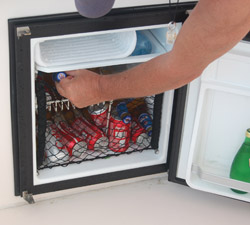 On the flying bridge is this handy little refrigerator built into the forward cowling. The problem was that after even a few minutes in the ocean at speed, when you open the door, all the cans of pop dump on the floor. One could even roll down into the cockpit and hit somebody. The owner’s solution was to install a cargo net with elastic sides allowing him to remove contents easily while keeping everything in place.
On the flying bridge is this handy little refrigerator built into the forward cowling. The problem was that after even a few minutes in the ocean at speed, when you open the door, all the cans of pop dump on the floor. One could even roll down into the cockpit and hit somebody. The owner’s solution was to install a cargo net with elastic sides allowing him to remove contents easily while keeping everything in place.
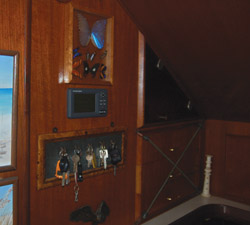 Companionways are often tight but there is still useful space. Years of cruising experience has resulted in the following improvements; bungee cords to secure the three drawers, a handy group of hooks for the many different keys needed to run this boat and a Furuno repeater for the autopilot with speed and course data.
Companionways are often tight but there is still useful space. Years of cruising experience has resulted in the following improvements; bungee cords to secure the three drawers, a handy group of hooks for the many different keys needed to run this boat and a Furuno repeater for the autopilot with speed and course data.

